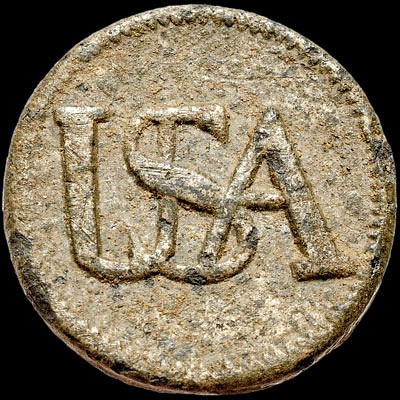1770-80 Engraved Print, L AMERIQUE, with AMERICA Depicted as an African Princess
Lot 260
Categories
Estimate:
$800 - $1,000
Absentee vs Live bid
Two ways to bid:
- Leave a max absentee bid and the platform will bid on your behalf up to your maximum bid during the live auction.
- Bid live during the auction and your bids will be submitted real-time to the auctioneer.
Bid Increments
| Price | Bid Increment |
|---|---|
| $0 | $10 |
| $200 | $20 |
| $300 | $25 |
| $500 | $50 |
| $1,000 | $100 |
| $2,000 | $200 |
| $3,000 | $250 |
| $5,000 | $500 |
| $10,000 | $1,000 |
| $20,000 | $2,000 |
| $30,000 | $2,500 |
| $50,000 | $5,000 |
| $100,000 | $10,000 |
| $200,000 | $20,000 |
| $300,000 | $25,000 |
| $500,000 | $50,000 |
About Auction
By Early American History Auctions
Aug 21, 2021
Set Reminder
2021-08-21 12:00:00
2021-08-21 12:00:00
America/New_York
Bidsquare
Bidsquare : Autographs - Historic & Political Americana - Militaria & Guns
https://www.bidsquare.com/auctions/early-american-history-auctions/autographs---historic-political-americana---militaria-guns-7321
335 Lots of Rare, Historic Autographs, Americana, Civil War Era, George Washington, Revolutionary War Era, Colonial America, Federal Period, War of 1812, Colonial Currency & more... Early American History Auctions auctions@earlyamerican.com
335 Lots of Rare, Historic Autographs, Americana, Civil War Era, George Washington, Revolutionary War Era, Colonial America, Federal Period, War of 1812, Colonial Currency & more... Early American History Auctions auctions@earlyamerican.com
- Lot Description
Historic Americana
"AMERICA" Depicted as an African Princess French Print
c. 1760-1780 Colonial to Revolutionary War Era, Classic Engraved Print titled, "L'AMERIQUE", with "AMERICA" Depicted as an African Princess, by Chez Noel, Paris, France, Crisp Very Fine.
A rarely encountered historic Theme Engraving. Original Engraved Copper Plate Print titled, "L'AMERIQUE" with outer Plate outline seen lightly embossed into the heavy period print paper measuring 7" x 10" with the Printed Portion 6.75" x 5.25" on a larger 12" x 8.75" Sheet. Some scattered light spotting in the outer selvage not affecting the Engraving, the designs and text are well printed in black. It depicts a bare-breasted African Princess holding a fancy umbrella as "America". She sits holding an umbrella in her right hand and a flower or plant's seed pod in her left hand. A large African elephant and native living huts shown in the background. Classic imagery with a connection to American and Black History possibly in connection to British Queen Charlotte, in 1761 became the wife of the English King George III (1738-1820), was directly descended from Margarita de Castro y Sousa, a black branch of the Portuguese Royal House.
British Queen Charlotte, with features as conspicuously Negroid as they were reputed to be by her contemporaries, it is no wonder that the black community, both in the U.S. and throughout the British Commonwealth, have rallied around pictures of Queen Charlotte for generations. They have pointed out the physiological traits that so obviously identify the ethnic strain of the young woman who, at first glance, looks almost anomalous, portrayed as she usually is, in the sumptuous splendor of her coronation robes.
Queen Charlotte, wife of the English King George III (1738-1820), was directly descended from Margarita de Castro y Sousa, a black branch of the Portuguese Royal House. The riddle of Queen Charlotte's African ancestry was solved as a result of an earlier investigation into the black magi featured in 15th century Flemish paintings.
Two art historians had suggested that the black magi must have been portraits of actual contemporary people (since the artist, without seeing them, would not have been aware of the subtleties in colouring and facial bone structure of quadroons or octoroons which these figures invariably represented) Enough evidence was accumulated to propose that the models for the black magi were, in all probability, members of the Portuguese de Sousa family. (Several de Sousas had in fact traveled to the Netherlands when their cousin, the Princess Isabella went there to marry the Grand Duke, Philip the Good of Burgundy in the year 1429.)
Six different lines can be traced from English Queen Charlotte back to Margarita de Castro y Sousa, in a gene pool which because of royal inbreeding was already minuscule, thus explaining the Queen's unmistakable African appearance.
Queen Charlotte's Portrait:
The Royal FamilyThe Negroid characteristics of the Queen's portraits certainly had political significance since artists of that period were expected to play down, soften or even obliterate undesirable features in a subjects's face.
Sir Allan Ramsay was the artist responsible for the majority of the paintings of the Queen and his representations of her were the most decidedly African of all her portraits. Ramsey was an anti-slavery intellectual of his day. He also married the niece of Lord Mansfield, the English judge whose 1772 decision was the first in a series of rulings that finally ended slavery in the British Empire. It should be noted too that by the time Sir Ramsay was commissioned to do his first portrait of the Queen, he was already, by marriage, uncle to Dido Elizabeth Lindsay, the black grand niece of Lord Mansfield.
- Shipping Info
-
Early American provides in-house worldwide shipping. Please contact us directly if you have questions about your specific shipping requirements.
-
- Buyer's Premium



 EUR
EUR CAD
CAD AUD
AUD GBP
GBP MXN
MXN HKD
HKD CNY
CNY MYR
MYR SEK
SEK SGD
SGD CHF
CHF THB
THB













